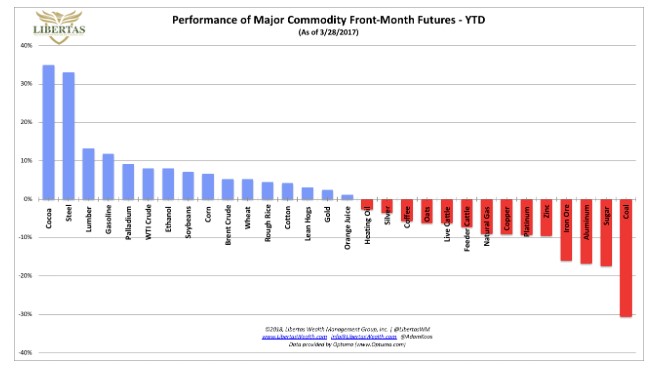Encouraged by growth in global economies and weakness in the U.S. dollar, a couple of commodities had a slight advantage over their declining brethren in the first quarter of this year—a volatile period characterized so far by a brewing trade war.
Steel and cocoa have so far been the winners of 2018—at least on the supply side—while coal and sugar were the biggest losers in the commodities patch.
This is how everyone in between fared:

(Click to enlarge)
Cocoa: The Biggest Q1 Winner, and Somehow Sweeter Than Sugar
Cocoa soared with the biggest quarterly gain and future up 35 percent thanks to production problems in West Africa.
The cocoa industry expected a small global surplus in 2017/18 of about 100,000 to 150,000 tones, according to Lionel Soulard, director of Cargill's cocoa-focused Africa business.
Offsetting a boom in production, there is constant demand growth.
Already producing two-thirds of the world’s cocoa, West Africa is set to take even more market share.
Steel: Stealing the Show on Strong Demand
Steel prices jumped 33 percent in the first quarter, according to S&P Global Platt’s data for U.S.-made hot-rolled steel coil.
“Steel demand has been strong and is running ahead of supply, and the three key consuming sectors of steel demand—construction, automotive and energy—are doing well,” says Joseph Innace, S&P Global Platts editorial director for metals in the Americas.
But declining Chinese demand and high inventories could hit at the potential upside to steel prices for the rest of the year.
Sugar: Too Much Sweet Supply
Sugar bottomed out at 10.13 cents per pound in August 2015, and this quarter dropped 17 percent—a dive driven by increasing supplies from India.
Brazil, the world's biggest sugar grower, provided some support with its frim currency against the U.S. dollar. After India relaxed its rules on sugar exports, the spot contract closed last month down 8.4 percent on supply gut concerns. Related: 92 Percent Of Blockchain Projects Are Doomed To Fail
The price of sugar has declined to a level that could threaten the pattern of higher lows that has been in place since 1985. While we could see another lower low in sugar, the staple is at a level where the odds favor long positions on a scale-down basis. The price of sugar has soured, but the staple commodity offers value at its current level—so the theory goes.
Coal: The Bad Boy Everyone Loves to Hate and Hates to Love
To say coal has been battered is an understatement, but it’s been a strange year for the dirty commodity.
While the World Bank’s global head of energy and extractives, Riccardo Puliti, has hit the stage predicting the near-death of coal, some actual numbers paint a more complicated story.
"The model has been coal plus renewables, the model can be gas plus renewables. I think 10, 12 years from now, we will see renewables and storage and nothing more than that," Puliti told CNBC.
The EIA won’t release its Quarterly Coal Report for Q12018 until July, but Q2 2017 results released on April 2 showed a clear pattern—until this year:

(Click to enlarge)
Rather contradictorily, global coal prices are expected to remain healthy throughout 2018 owing to stable demand from China and increasing consumption in India, says the World Coal Association (WCA).
And China’s National Bureau of Statistics show coal consumption up 0.7 percent last year for the first time in 4 years. It remains the key to over 60 percent of China’s energy mix. Last year also saw an increase in global coal consumption after two years of decline, according to the International Energy Agency (IEA).
By Tom Kool for Safehaven.com
More Top Reads From Safehaven.com:

















